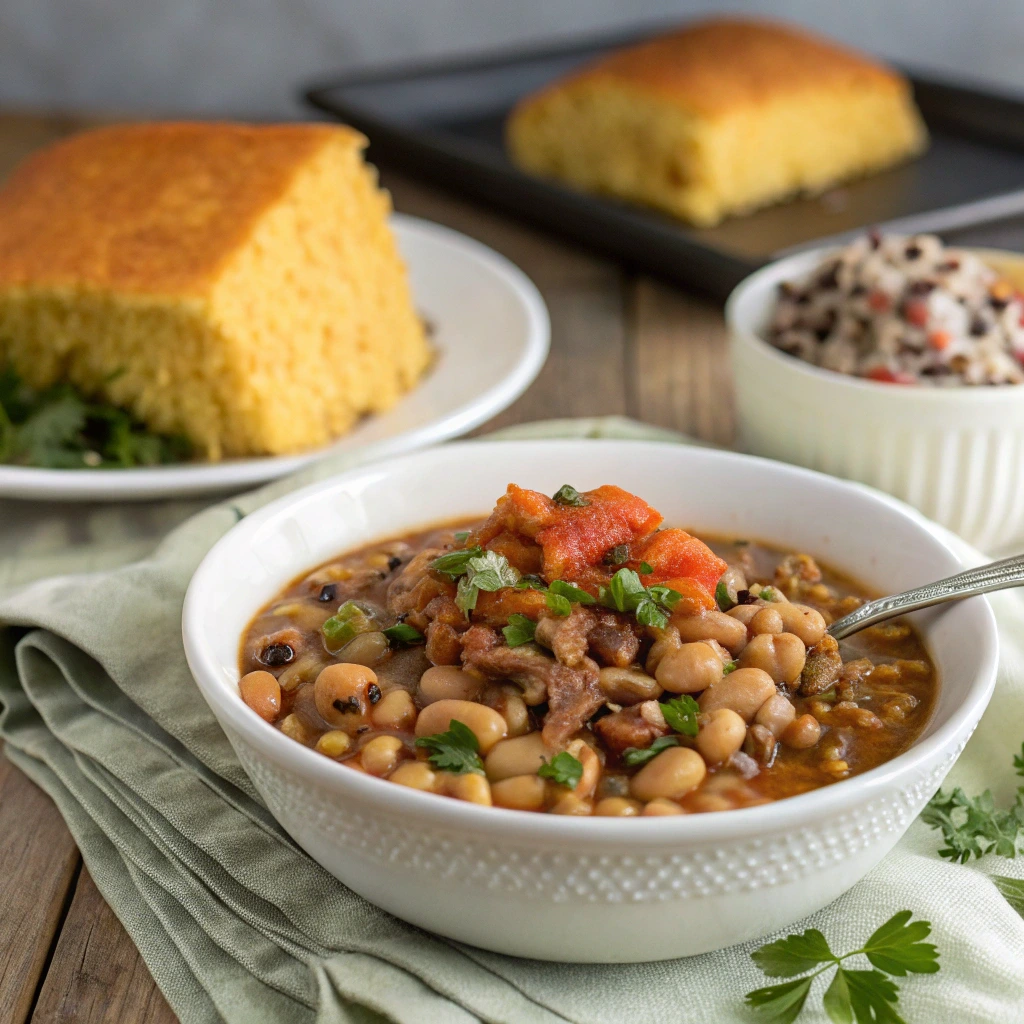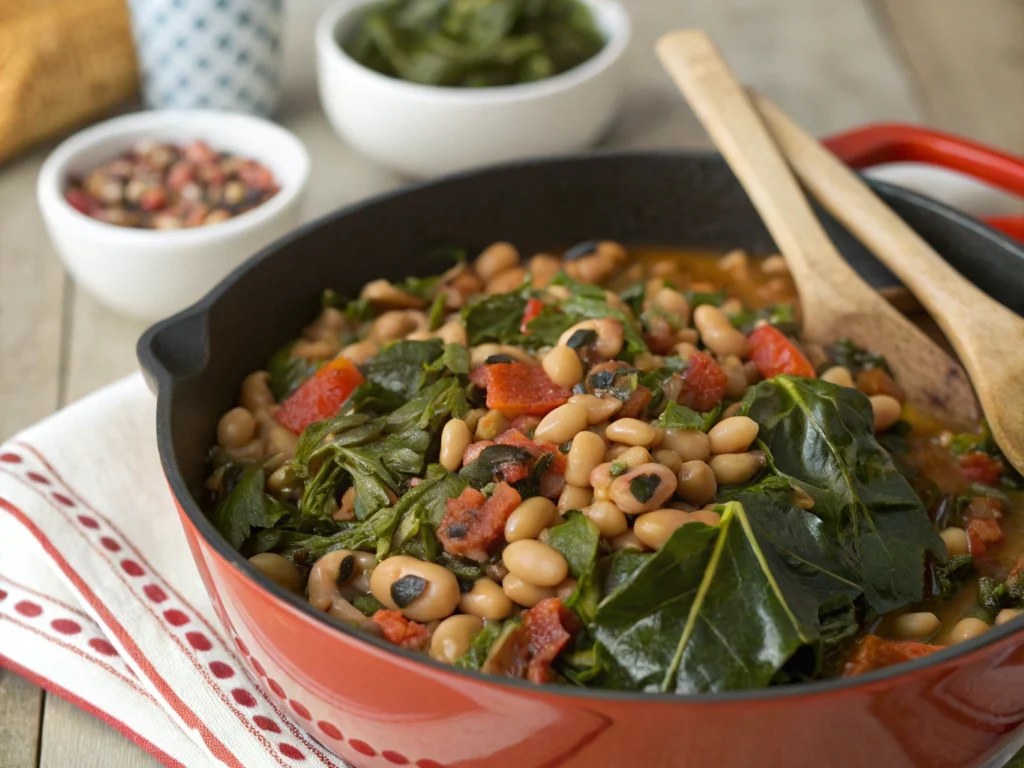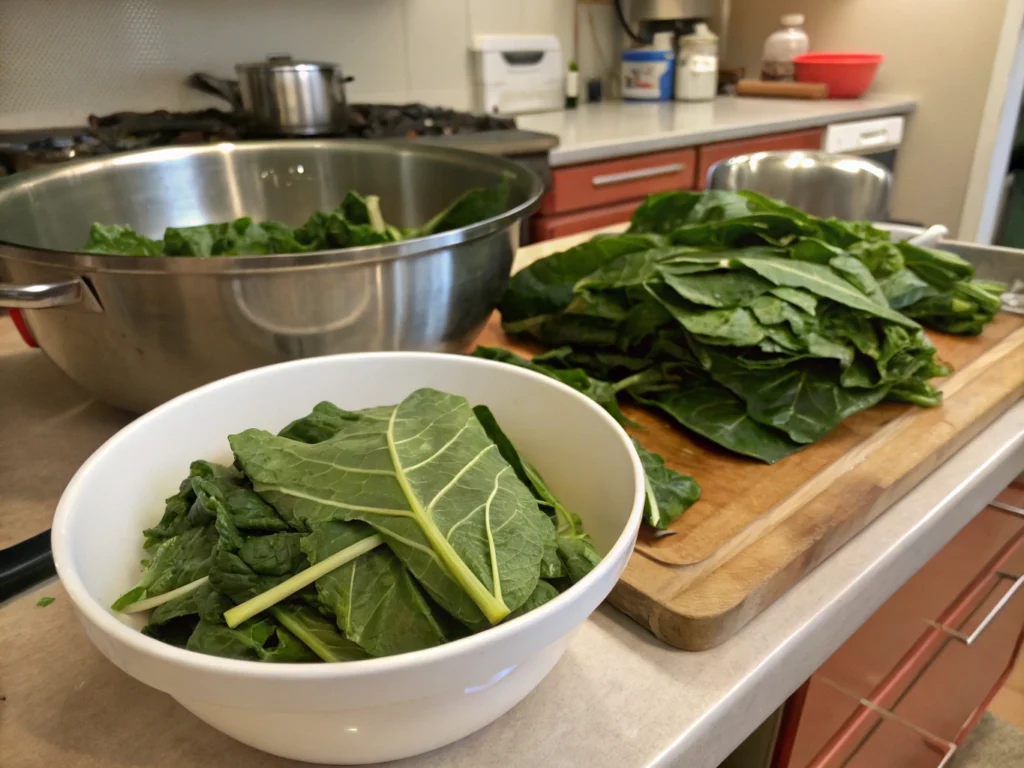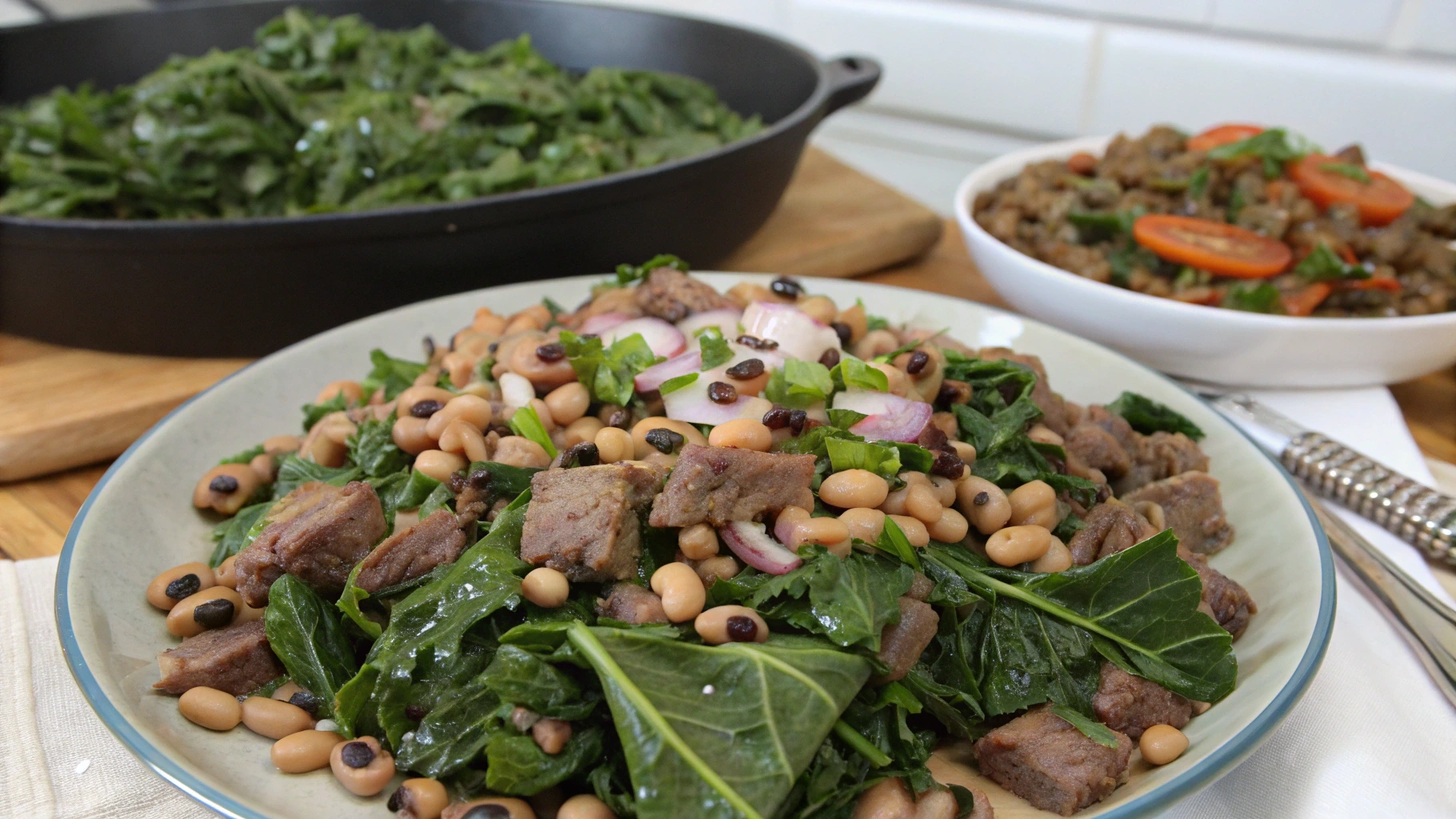Black Eyed Peas Collard Greens: Recipes, Tips, and Benefits are a staple of Southern cuisine, cherished for their rich flavors and incredible nutritional value. These two ingredients have stood the test of time, offering endless ways to create comforting, wholesome meals. Whether you’re exploring traditional recipes or seeking modern twists, black eyed peas and collard greens bring bold taste and health benefits to the table.
We’ll explore how these nutrient-rich foods contribute to a balanced diet, share traditional and innovative recipes, and offer tips to make the most of their natural goodness. From their cultural significance to modern uses, this guide will help you embrace the Black Eyed Peas Collard Greens duo like a pro.
Introduction to Black Eyed Peas and Collard Greens Traditions
Black eyed peas and collard greens hold a special place in Southern culinary traditions. Known as symbols of good luck and prosperity, they’re often featured in meals celebrating New Year’s Day. However, their appeal goes far beyond folklore. These ingredients are staples in kitchens worldwide, thanks to their adaptability and nutrient-dense profiles.
Black eyed peas, a variety of legumes, are prized for their earthy flavor and ability to complement a wide range of dishes. Collard greens, a member of the brassica family, bring a slightly bitter but deeply satisfying flavor, perfect for stews, sautés, and even wraps. Together, they create a hearty, comforting combination that’s both filling and wholesome.
Health Benefits and Nutritional Value of These Superfoods
Beyond their cultural significance, black eyed peas and collard greens are powerhouses of nutrition. Black eyed peas are high in protein, fiber, and essential minerals like magnesium and folate, making them a valuable addition to vegetarian and omnivorous diets alike. Collard greens shine as a source of vitamins A, C, and K, alongside iron and calcium.
When combined, these ingredients offer a perfect balance of macronutrients and micronutrients, supporting digestion, immunity, and overall health. Whether you’re looking to boost your fiber intake or simply enjoy a hearty meal, black eyed peas and collard greens are the way to go.
Nutritional Benefits of Black Eyed Peas
High in Fiber and Antioxidants: Supporting Digestive and Cellular Health
Black eyed peas are more than just a tasty addition to your plate—they’re a treasure trove of digestive-friendly fiber and disease-fighting antioxidants. The high fiber content in these legumes supports a healthy gut, helping regulate bowel movements and promoting the growth of good bacteria. Antioxidants like flavonoids, found abundantly in black eyed peas, play a critical role in reducing inflammation and combating free radicals that can damage cells.
This dynamic combination of nutrients not only aids digestion but also contributes to better overall health. By including these legumes in your meals, you’re giving your body the tools it needs to thrive.
Rich in Essential Vitamins and Minerals for Overall Wellness
Packed with essential vitamins like folate and minerals such as iron, magnesium, and zinc, black eyed peas are nutritional heavyweights. Folate, a B-vitamin crucial for cellular growth and repair, makes black eyed peas an excellent choice for pregnant women or those trying to maintain optimal health.
Iron supports healthy blood oxygenation, while magnesium and zinc contribute to muscle function and immunity. When paired with nutrient-rich collard greens, these legumes create a perfect storm of health benefits that align seamlessly with the theme of Black Eyed Peas Collard Greens: Recipes, Tips, and Benefits.
Incorporating Black Eyed Peas into a Balanced Diet
Integrating black eyed peas into your meals is incredibly easy. They’re perfect for soups, stews, salads, and even veggie burgers. Their hearty texture and mild flavor make them a versatile ingredient that pairs wonderfully with collard greens. A simple bowl of black eyed peas and greens can transform an ordinary meal into a nutritional powerhouse.
Nutritional Benefits of Collard Greens
A Powerhouse of Vitamins: Vitamin A, C, and K Explained
Collard greens are a true superfood, brimming with vitamins A, C, and K. Vitamin A promotes healthy vision and immune function, while vitamin C boosts collagen production and strengthens the immune system. Vitamin K, on the other hand, is essential for blood clotting and bone health, making collard greens a must-have in any diet.
Regularly consuming collard greens can help prevent vitamin deficiencies while supporting overall wellness. They’re an especially good choice for those looking to improve skin health and strengthen bones naturally.
The Role of Magnesium, Iron, and Calcium in Collard Greens
Minerals like magnesium, iron, and calcium in collard greens play vital roles in maintaining optimal health. Magnesium supports muscle function and nerve signaling, while iron helps prevent anemia by boosting red blood cell production. Calcium is essential for strong bones and teeth, making these greens an excellent choice for individuals of all ages.
By pairing collard greens with black eyed peas, you’re combining two nutrient-rich foods that complement each other perfectly. The result? A delicious and wholesome dish that’s as good for your body as it is for your taste buds.
Boosting Immunity with Phytonutrients in Greens
Collard greens also contain powerful phytonutrients, which are natural compounds that enhance immunity and protect against chronic diseases. These antioxidants help the body fend off environmental stressors and promote long-term health.
When exploring Black Eyed Peas Collard Greens: Recipes, Tips, and Benefits, it’s clear that collard greens aren’t just another leafy vegetable—they’re a nutritional superstar that deserves a place on your plate.
Traditional Recipes Featuring Black Eyed Peas and Collard Greens
Classic Black Eyed Peas with beef or Vegetarian Substitutes

One of the most beloved recipes in Southern cuisine is a steaming pot of black eyed peas cooked with ham hocks. The smoky flavor from the beef infuses the peas, creating a hearty, comforting dish. For a vegetarian twist, replace the beef with smoked paprika, liquid smoke, or shiitake mushrooms to mimic the savory, umami taste.
Start by sautéing onions, garlic, and celery in olive oil. Add soaked black eyed peas, your choice of broth, and seasonings like thyme, bay leaves, and black pepper. Let it simmer until the peas are tender and the flavors meld together. Serve over rice for a complete meal.
Southern-Style Collard Greens with Cornbread Pairing
Collard greens slow-cooked with onions, garlic, and smoked turkey or bacon are a Southern classic. The greens’ natural bitterness mellows as they simmer in a flavorful broth, often referred to as potlikker. This broth is a nutrient-packed delight, perfect for soaking up with a slice of cornbread.
To prepare, remove the stems from the greens, chop them, and rinse thoroughly. In a pot, sauté onions and garlic, then add the greens, a bit of vinegar, and your choice of smoked meat or vegetarian substitutes. Cover with broth and cook low and slow until tender. Pair with hot cornbread for a timeless meal.
One-Pot Black Eyed Peas and Greens: A Fusion Dish

Combine the best of both worlds with a one-pot meal featuring black eyed peas and collard greens. This dish is perfect for a quick, nutritious dinner. Start by sautéing onions, garlic, and carrots. Add soaked black eyed peas, chopped collard greens, and vegetable or chicken broth. Season with smoked paprika, cumin, and red pepper flakes for a slight kick.
Allow everything to simmer until the peas are soft and the greens are tender. Garnish with fresh herbs like parsley or thyme and serve with crusty bread or rice.
For more delicious recipes like this, check out The Timeless Combination: Black Eyed Peas & Collard Greens.
Creative and Modern Takes on Black Eyed Peas and Collard Greens
Black Eyed Peas Salad with Lemon Vinaigrette
Looking for a fresh and vibrant dish? A black eyed peas salad with lemon vinaigrette is a light yet satisfying option. Toss cooked black eyed peas with chopped cucumbers, cherry tomatoes, red onion, and parsley. Drizzle with a dressing made of olive oil, lemon juice, garlic, and Dijon mustard.
This salad is perfect as a side dish or a standalone meal. It’s packed with fiber and vitamins, making it a nutritious choice for any occasion.
Stuffed Collard Greens: A Twist on Traditional Dolmas
Put a spin on stuffed grape leaves by using collard greens instead. Blanch the leaves to make them pliable, then stuff them with a mixture of cooked rice, lentils, and herbs like dill and mint. Add a touch of smoked paprika for depth.
Roll the leaves tightly, place them in a pot, and simmer with a tangy tomato broth. These stuffed greens are an excellent appetizer or light meal.
Black Eyed Peas and Collard Greens Soup: A Nutritious Meal
For a comforting bowl of soup, combine black eyed peas and collard greens in a hearty broth. Sauté onions, garlic, and celery in olive oil. Add chopped greens, cooked peas, and vegetable or chicken stock. Season with thyme, bay leaves, and a pinch of cayenne.
This soup is warm, flavorful, and brimming with nutrients, making it an ideal winter dish.
Cooking Tips and Techniques for Maximum Flavor
Soaking and Cooking Black Eyed Peas for Optimal Texture
To get the best texture from black eyed peas, proper soaking and cooking are key. If you’re using dried peas, soak them overnight in water to reduce cooking time and improve digestibility. Short on time? Use the quick-soak method: boil the peas for 2 minutes, then let them sit for an hour before cooking.
When cooking, add aromatics like onions, garlic, or bay leaves to the pot for extra flavor. Avoid adding salt or acidic ingredients (like tomatoes) until the peas are nearly tender to prevent toughening. Cook on a gentle simmer, and they’ll be creamy and perfectly tender every time.
How to Prepare and Cook Collard Greens Without Losing Nutrients

Collard greens are packed with vitamins, but overcooking can lead to nutrient loss. To retain their goodness, try blanching the greens before cooking. Blanching also reduces bitterness and softens the leaves, making them easier to cook.
For a quick sauté, chop the greens into strips and cook them in olive oil with garlic, onions, and a splash of broth. For longer cooking methods, such as stewing, add the greens toward the end to preserve their vibrant color and nutrients.
Enhancing Flavor with Spices, Aromatics, and Broth
The secret to making black eyed peas and collard greens truly shine lies in layering flavors. Use smoked meats or vegetarian alternatives like smoked paprika to create depth. Include fresh herbs like thyme or parsley and a splash of vinegar or lemon juice to brighten the dish.
Cooking in broth instead of water elevates the taste, giving the dish a rich and hearty base. These tips ensure your Black Eyed Peas Collard Greens: Recipes, Tips, and Benefits are as flavorful as they are nutritious.
FAQs About Black Eyed Peas and Collard Greens
What Are the Best Substitutes for Black Eyed Peas in Recipes?
If you’re out of black eyed peas, other legumes like navy beans, cannellini beans, or chickpeas make excellent substitutes. These options share a similar creamy texture and mild flavor, fitting well into most recipes.
Can You Freeze Collard Greens and Black Eyed Peas After Cooking?
Yes! Both black eyed peas and collard greens freeze well, making meal prep a breeze. To freeze, allow the cooked dish to cool completely before transferring it to an airtight container. Properly stored, they can last up to three months in the freezer.
Are Black Eyed Peas and Collard Greens Suitable for a Vegan Diet?
Absolutely. Both ingredients are naturally vegan and pair beautifully with plant-based seasonings like garlic, onions, smoked paprika, and vegetable broth. These dishes can easily be adapted to suit vegan diets while maintaining bold, delicious flavors.
For more guidance on using these ingredients in your kitchen, explore Black Eyed Peas Collard Greens: Recipes, Tips, and Benefits to learn how to make the most of these superfoods.
Related Benefits and Lesser-Known Uses
Exploring Potlikker: The Nutritious Broth from Collard Greens
When cooking collard greens, don’t toss the leftover broth, known as potlikker. This flavorful liquid is brimming with nutrients from the greens, including vitamins A, C, and K, as well as calcium and iron. It’s more than just a byproduct—it’s a Southern staple often sipped as a soup or used to enrich other dishes.
Potlikker is versatile. Add it to soups, stews, or even grains like rice or quinoa for an added boost of flavor and nutrients. By incorporating potlikker into your meals, you’re embracing both sustainability and the full nutritional potential of collard greens.
Sustainability and Environmental Benefits of Growing Black Eyed Peas and Collard Greens
Black eyed peas and collard greens aren’t just great for your health—they’re also environmentally friendly crops. Black eyed peas enrich the soil with nitrogen, reducing the need for chemical fertilizers. Similarly, collard greens are hardy plants that thrive in a variety of climates, making them a sustainable choice for small and large-scale farming.
By choosing these ingredients, you’re supporting sustainable agriculture while enjoying their health benefits. As discussed throughout Black Eyed Peas Collard Greens: Recipes, Tips, and Benefits, these foods offer a win-win for your plate and the planet.
Conclusion and Final Thoughts
Throughout this article, we’ve explored the rich culinary heritage and incredible health benefits of black eyed peas and collard greens. From their deep roots in Southern traditions to their modern adaptations, these ingredients prove they’re more than just staples—they’re superfoods that deserve a spot in any kitchen.
By embracing the recipes, tips, and benefits shared here, you can enjoy meals that are as flavorful as they are nourishing. Whether you’re savoring classic black eyed peas with cornbread or experimenting with innovative takes like stuffed collard greens, the possibilities are endless.
Moreover, incorporating these sustainable ingredients into your meals not only supports your health but also contributes to eco-friendly eating habits. From the nutritious potlikker to the soil-enriching benefits of growing black eyed peas, these foods have so much to offer.
Ready to start your culinary journey? Try one of the recipes highlighted in Black Eyed Peas Collard Greens: Recipes, Tips, and Benefits, and discover why this duo has stood the test of time. Happy cooking!

